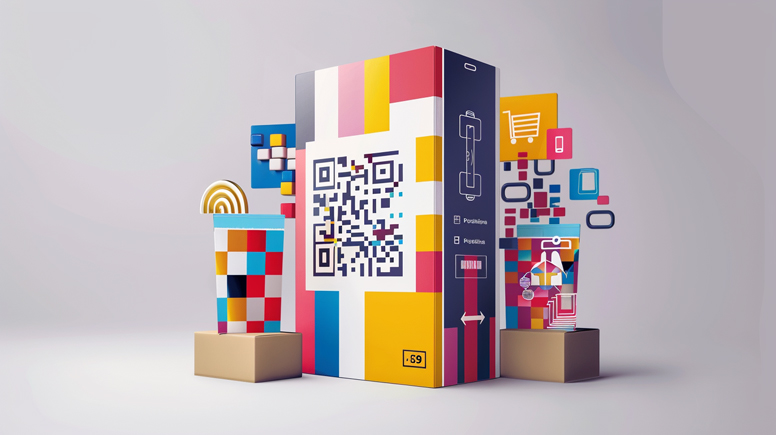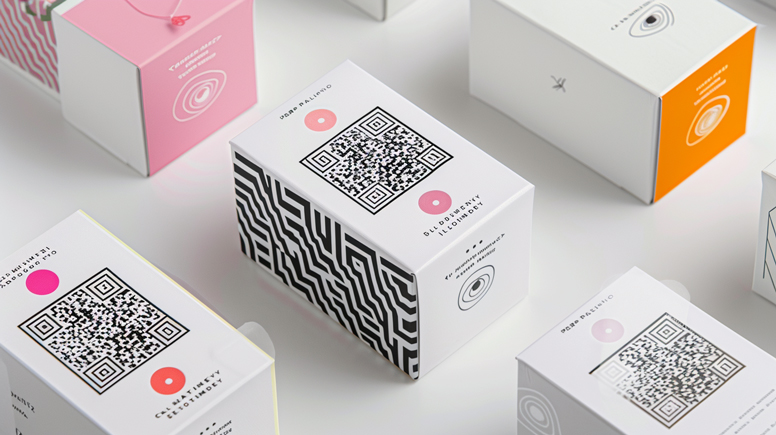QR Packaging: Creating Immersive Experiences with QR Codes

By Brad Holmes|June 24, 2024|7 mins read
The packaging industry is embracing minimalism, allowing brands to highlight essential product information. However, with the integration of Quick Response (QR) codes, even a simple design can offer vast amounts of information.
QR codes act as a gateway to content beyond what physical packaging can accommodate, offering additional product details, usage instructions, sustainability initiatives, reviews, and interactive experiences. This technology helps brands create an enhanced customer experience by fostering informed purchasing decisions.

At a Glance
What Are QR Codes?
Quick Response (QR) codes, are two-dimensional barcodes that can store a wealth of information accessible with a quick scan using a smartphone or dedicated code reader. Developed in 1994 by Denso Wave, a subsidiary of Toyota, QR codes were initially used to track automotive parts during manufacturing. Today, their use has expanded across various industries, including marketing, retail, and logistics.
A QR code consists of black squares arranged on a white background, encoding data both horizontally and vertically, allowing for a higher data capacity compared to traditional barcodes. This compact format can hold URLs, text, contact information, and more, making them versatile tools for connecting the physical and digital worlds.
Consumers can easily scan the codes using their smartphone cameras, leading to a seamless interaction that quickly directs them to websites, product information, videos, and other digital content. This immediacy and ease of use have made QR codes a popular choice for brands looking to enhance customer engagement and provide additional information without cluttering their packaging designs.
7 Reasons to Use QR Codes on Your Packaging
QR codes have become a vital tool for enhancing customer engagement and delivering a wealth of information right from the packaging. By integrating codes, brands can bridge the gap between physical products and digital content, offering customers a seamless and enriched shopping experience. Here are seven compelling reasons to incorporate QR codes into your packaging strategy.
- Product Reviews
Consumers rely heavily on reviews before making purchases, with nine in ten considering them crucial. QR codes can direct customers to read or leave reviews, helping them make informed decisions and providing brands with valuable feedback. - How-to Videos
QR codes can link to video tutorials, showcasing product usage and functionality. These videos help customers understand products better, reducing returns and dissatisfaction by setting clear expectations. - Sustainability Information
With nearly 80% of US consumers willing to change shopping habits for sustainability, QR codes can share a brand’s eco-friendly initiatives, connecting with environmentally conscious buyers and building brand loyalty. - Product Authenticity
QR codes can verify product authenticity by tracing its journey from origin to store. This transparency enhances brand credibility and assures customers of the product’s quality and origins. - Interactive Product Experiences
QR codes can create immersive experiences through augmented reality (AR). For example, Puma used QR codes in its flagship store to link customers to an AR interaction with the Puma mascot, enhancing customer engagement. - Social Media Traffic
QR codes can drive traffic to social media pages, increasing engagement and brand visibility. A single landing page can list all social media accounts, making it easy for customers to connect. - Retargeting
Dynamic codes enable retargeting efforts. If a consumer scans a QR code but doesn’t purchase, cookies can track their interest, allowing brands to retarget them with specific ads, increasing the likelihood of conversion.

Case Studies
Brands are constantly seeking innovative ways to enhance customer engagement and satisfaction. One effective tool that has gained significant traction is the integration of Quick Response (QR) codes on product packaging. These small, yet powerful codes have transformed static packaging into dynamic portals, offering consumers instant access to a wealth of digital content right from their smartphones. From nutritional information and tutorials to promotional offers and sustainability initiatives, QR codes provide brands with a versatile platform to educate, inform, and connect with their customers like never before. Let’s explore how leading brands like Heinz and L’Oreal have successfully utilized QR codes to enrich their customer experience and drive brand loyalty.
Objective: Heinz aimed to enhance customer engagement and provide convenient access to nutritional information.
Implementation: Heinz strategically integrated QR codes onto their ketchup bottles. These QR codes were designed to provide customers with instant access to a variety of content, including recipes featuring Heinz products, detailed nutritional facts, and promotional offers. Customers could simply scan the QR code with their smartphones to unlock this additional information.
Results: The implementation of QR codes on Heinz ketchup bottles led to significant outcomes for the brand:
- Increased Customer Interaction: Customers engaged more actively with the brand by accessing additional digital content directly from the product packaging.
- Improved Product Knowledge: Access to detailed nutritional information and recipe ideas enhanced customers’ understanding of Heinz products.
- Strengthened Brand Loyalty: By providing valuable and easily accessible information, Heinz fostered stronger connections with customers, leading to increased brand loyalty and repeat purchases.
Overall, Heinz’s use of QR codes effectively transformed their product packaging into an interactive platform that not only provided functional benefits like nutritional transparency but also enriched the overall customer experience, contributing to long-term brand loyalty and customer satisfaction.
Objective: L’Oreal aimed to enhance customer experience by providing easy access to product information and tutorials directly from their cosmetic packaging.
Implementation: L’Oreal integrated QR codes onto their cosmetic products, enabling customers to scan the codes with their smartphones. These QR codes directed customers to a range of digital content, including makeup tutorials, skincare tips tailored to specific products, and user-generated product reviews. This initiative aimed to educate customers on product usage, application techniques, and benefits directly at the point of purchase.
Results: The introduction of QR codes on L’Oreal cosmetic packaging yielded several positive outcomes:
- Improved Customer Satisfaction: By offering educational content such as tutorials and skincare tips, L’Oreal enhanced customer satisfaction and confidence in product usage.
- Reduced Returns: Clearer product expectations set through accessible information helped reduce instances of returns due to misunderstanding or dissatisfaction.
- Enhanced Engagement: Customers engaged more deeply with the brand through interactive content, leading to increased brand loyalty and advocacy.
Overall, L’Oreal’s implementation of QR codes exemplified their commitment to enhancing the customer journey by leveraging digital technology to provide valuable, educational content directly on product packaging. This strategy not only improved customer satisfaction but also contributed to a more informed and empowered customer base.
Objective: PepsiCo aimed to enhance transparency, build consumer trust, and cater to eco-conscious consumer preferences by providing detailed product information and highlighting sustainability initiatives.
Implementation: PepsiCo strategically integrated QR codes onto their snack and beverage packaging. These QR codes were designed to provide consumers with immediate access to comprehensive information such as:
- Nutritional Information: Detailed breakdown of ingredients, calorie content, and nutritional values.
- Recycling Instructions: Guidance on how to properly recycle the packaging materials to promote sustainability.
- Sustainable Sourcing Practices: Information about PepsiCo’s efforts in sustainable sourcing, including ethical procurement of ingredients and environmental conservation initiatives.
Results: The implementation of QR codes on PepsiCo’s packaging led to significant benefits for the brand:
- Enhanced Transparency: Consumers appreciated the transparency provided through detailed product information and sustainability initiatives, which strengthened trust in the brand.
- Improved Consumer Trust: By openly sharing information on sourcing practices and environmental impact, PepsiCo bolstered consumer confidence and loyalty.
- Alignment with Consumer Preferences: Meeting the growing demand for eco-friendly products and corporate responsibility initiatives helped PepsiCo align its brand values with those of environmentally conscious consumers.
Overall, PepsiCo’s use of QR codes effectively transformed their product packaging into a platform for education and transparency. This strategy not only enhanced consumer trust but also positioned PepsiCo as a leader in corporate responsibility, contributing to long-term brand loyalty and positive consumer perception.
Read our post on Mastering Custom Cardboard Boxes
5 Best Practices for Using QR Codes on Product Packaging
To maximize the effectiveness of QR codes on your product packaging, it’s crucial to implement best practices that ensure a seamless and engaging customer experience. Here are five key strategies to get the most out of QR codes and enhance your brand’s communication efforts.
1. Add Personalized QR Codes
Use brand colors and logos to make codes visually appealing and easier to scan.
2. Ensure the Code is Scannable
Test codes before printing to ensure they are neither too small nor blurry, avoiding costly reprints.
3. Include a Compelling Call-to-Action (CTA)
Personalize codes with relevant CTAs to encourage customers to scan them.
4. Focus on Placement
Place codes prominently on the packaging, similar to the strategic placement of CTA buttons on websites.
5. Avoid Multiple QR Codes
Use a single QR code that leads to a landing page offering multiple experiences, rather than cluttering the package with multiple codes.
As 87% of consumers use their smartphones to research products in-store, QR codes are a strategic solution. They provide an abundance of information in a tiny space, enhancing the customer journey and strengthening brand relationships. Embracing QR technology aligns with the research-oriented habits of modern consumers, offering a seamless and informative shopping experience.
Final Thoughts
QR codes have revolutionized the way brands communicate with their customers. By incorporating QR codes into packaging, brands can offer a wealth of information and interactive experiences without compromising on design. This technology not only meets the demands of modern, tech-savvy consumers but also enhances their shopping journey by providing instant access to detailed product information, reviews, tutorials, and sustainability efforts.
Embracing QR codes allows brands to foster informed purchasing decisions, build stronger connections with their audience, and stay ahead in an increasingly competitive market. By following best practices and strategically integrating QR codes, brands can transform their packaging into a dynamic communication tool, paving the way for a more engaging and informative customer experience.
Let’s Start Designing Your Custom Packaging!
We hope our guide to QR Codes helps you as you begin your product packaging journey! If you have any questions or are ready to get started creating beautiful product packages, reach out to our experts at Packaging Studio.